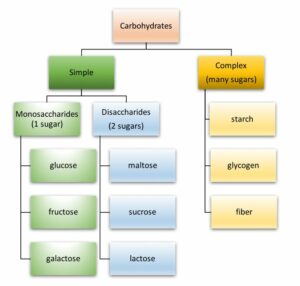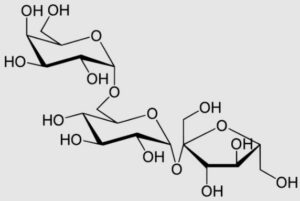Firstly the term carbohydrate was used to define chemical compounds having an empirical formula CH2O.
Carbohydrates have been classified based on their structure, not by their formulae. Carbohydrates are the aldehydes and ketones having multiple hydroxyl groups hence known as polyhydroxy. Glycogen, Starch and Cellulose are amongst the composites that belong to carbohydrate family.
What’s the structure of carbohydrates?
Carbohydrates, such as starch, cellulose, and sugars, are organic molecules found in biological tissues and foods.
Sugars have a similar oxygen-to-hydrogen proportion as water, which is 2:1. It normally breaks down in the body of the organism to give out energy. The formula for all the carbohydrates is Cn(H2O)n, it applies for simple sugars. Sugars are “optically active as well.
Carbohydrates are also known as saccharides, a Greek term that meaning “sugar,” because nearly all carbohydrates have a sweet flavor. The word carbohydrate or carbon hydrate comes from its basic constituent formula, which has carbon linked to hydrogen and oxygen in the same ratio as water.
Grain carbohydrate classification is based on chemical structures or digestibility when taken by humans as food or by cattle as feed. Sugars or disaccharides are simple carbohydrates that are sweet and soluble in water, and the names of most sugars end in -ose. As a result, we have terms like sucrose for regular table sugar, glucose for blood sugar, and maltose for malt sugar.
Classification of carbohydrates

Carbohydrates are differentiated into two classes:
on the basis of their chemical structure and polymerization
Simple Carbohydrates
One, two, or a few sugar molecules constitutes the simple carbohydrates. They’re abundant in milk, vegetables, fruits and grains. These carbohydrates are referred to be “empty calories” since they lack minerals, vitamins and fibre.
are examples of simple carbohydrates.
Monosaccharides
Monosaccharides are sugars comprised of just one sugar unit. The quantity of carbon atom in the sugar atom is utilized to additionally differentiate monosaccharides.
Monosaccharide carbohydrates are those that cannot be further hydrolyzed to produce simpler polyhydroxy aldehyde or ketone molecules. Aldose alludes to a monosaccharide that has an aldehydic group, while ketose alludes to a monosaccharide that contains a keto group.
(i)Trioses (C3H6O3): Contain three carbon atoms. Example: Glyceraldehyde
(ii)Tetroses (C4H6O4): Contain four carbon atoms. Example: Erythrose
(iii) Pentoses: Contains five carbon atoms. Example: Ribose
(iv) Hexoses: contain six carbon atoms. Example: Glucose
(v) Heptoses: Contain seven carbon atoms. Example: Mannoheptulose
And so on.

Disaccharides
A disaccharide is synthesized when two monosaccharide sugars join properly. Examples: Sucrose, Lactose, Maltose, etc.
• When disaccharides are hydrolyzed, they produce two molecules of monosaccharides that are either the same or distinct.
• An oxide linkage, created by the loss of a water molecule, connects the two monosaccharide units, and this linkage is known as glycosidic linkage.
• Sucrose hydrolyze into glucose and fructose.
• Maltose (malt sugar) and lactose (commonly known as milk sugar) also belong to the class of disaccharides.
• There are two -D-glucose in maltose and one D-glucose and one D-galactose in lactose that are joined by a glycosidic bond.

Oligosaccharides
“Few” is the meaning of the word “oligo.” Oligosaccharides are carbohydrate molecules generated by the condensation of 2-9 monomers (short chains of monosaccharides).
Oligosaccharide examples are Raffinose and stachyose.

Complex Carbohydrates (Polysaccharides)
Carbohydrate rich food varieties contain at least two sugar units and are thus alluded to as complex carbohydrates. In contrast with simple carbs, complex carbs are digested gradually.
- Lentils, beans, peanuts, potatoes, peas, maize, whole-grain bread, cereals, and other legumes.
- Polysaccharides are made up of lengthy monosaccharide units linked together by glycosidic linkage, and the majority of them, such as starch, serve as food storage. Plants use starch as their primary storage polysaccharide.
- It is a glucose polymer comprised of two parts: Amylose and Amylopectin.
- Cellulose is quite possibly the most widely found polysaccharide in plant cell wall.
- It is comprised of D-glucose units connected together by a glycosidic linkage between C1 of one glucose unit and C4 of the following.
- Amylose and amylopectin are the two parts of starch. Amylopectin is a chain with branched structure that beginnings with amylose and terminates with amylopectin.
- Glycogen is found in animals and it is a similar to starch. however with more prominent branching pattern.
The structural element of the plant cell wall is cellulose, which is a carbohydrate polymer. It’s a tough and fibrous polysaccharide. In contrast to starch and glycogen, cellulose polymerizes to give a linear structure.
What does the chemical structure of a carbohydrate look like?
Sugars are comprised of carbon (C), hydrogen (H), and oxygen (O), with hydrogen being double in number as compared with carbon and oxygen.
Carbs are simple sugars or monosaccharides in their most basic structure. These monomers can be joined to make more complex carbs. A disaccharide is a compound made up of two simple sugars. Carbohydrates containing two to ten simple sugars are known as oligosaccharides, whereas those with more are known as polysaccharides.
Sugars, starches, cellulose, and an assortment of different biomolecules found in living organisms are instances of carbohydrates.

Stereochemistry
Chemical and biological properties differ across saccharides with similar functional groups but differing spatial arrangements. Stereochemistry is the investigation of how atoms are organized in three dimensions. Stereoisomers are structures in which the atoms are associated in a similar pattern however are organized in a different way.
Enantiomers are structures that are mirror images of one another however are not same, like left and right shoes. Example D-Glucose and L-Glucose. By flipping and rotating identical molecules, they can be made to correspond to one another.
By flipping and rotating enantiomers, notwithstanding, they can’t be made to compare to their identical representations. Because it provides a more accurate representation of the molecule’s binding angles, glucose is frequently depicted as a “chair form.” Glucose in the “boat” form is unstable.
What are the polymers of carbohydrates?
There are several polymers of carbohydrates found in living organisms.
- Starch: Polymer of glucose joined together by alpha-1,4-glycosidic linkages.
- Glycogen: Polymer of glucose joined together by alpha-1,4-glycosidic linkages.
- Cellulose: Polymer of glucose joined together by Beta-1,4-glycosidic linkages.
- Chitin: Polymer of N-Acetyl-Aminoglucose joined together by Beta-1,4-glycosidic linkages.
Starch is the stored food of plants while glycogen is the stored energy reserve/food found in animals. Cellulose is the component of plant cell wall while Chitin is the component of fungal cell wall and exoskeleton on insects.
Which atom is present in the structure of carbohydrates?
Sugars are comprised of carbon (C), hydrogen (H), and oxygen (O), with hydrogen being double in number as compared with carbon and oxygen
The formula in general for all carbohydrates is Cn(H2O)n. This equation just applies to simple sugars that contain a similar amount of carbon and water.
Also Read:
- Is chemical change reversible
- Why chemical change is irreversible
- How can a chemical change be reversed
- How chemical change occurs

I am Abdullah Arsalan , Completed my PhD in Biotechnology. I have 7 years of research experience. I have published 6 papers so far in the journals of international repute with an average impact factor of 4.5 and few more are in consideration. I have presented research papers in various national and international conferences. My subject area of interest is biotechnology and biochemistry with special emphasis on Protein chemistry, enzymology, immunology, biophysical techniques and molecular biology.